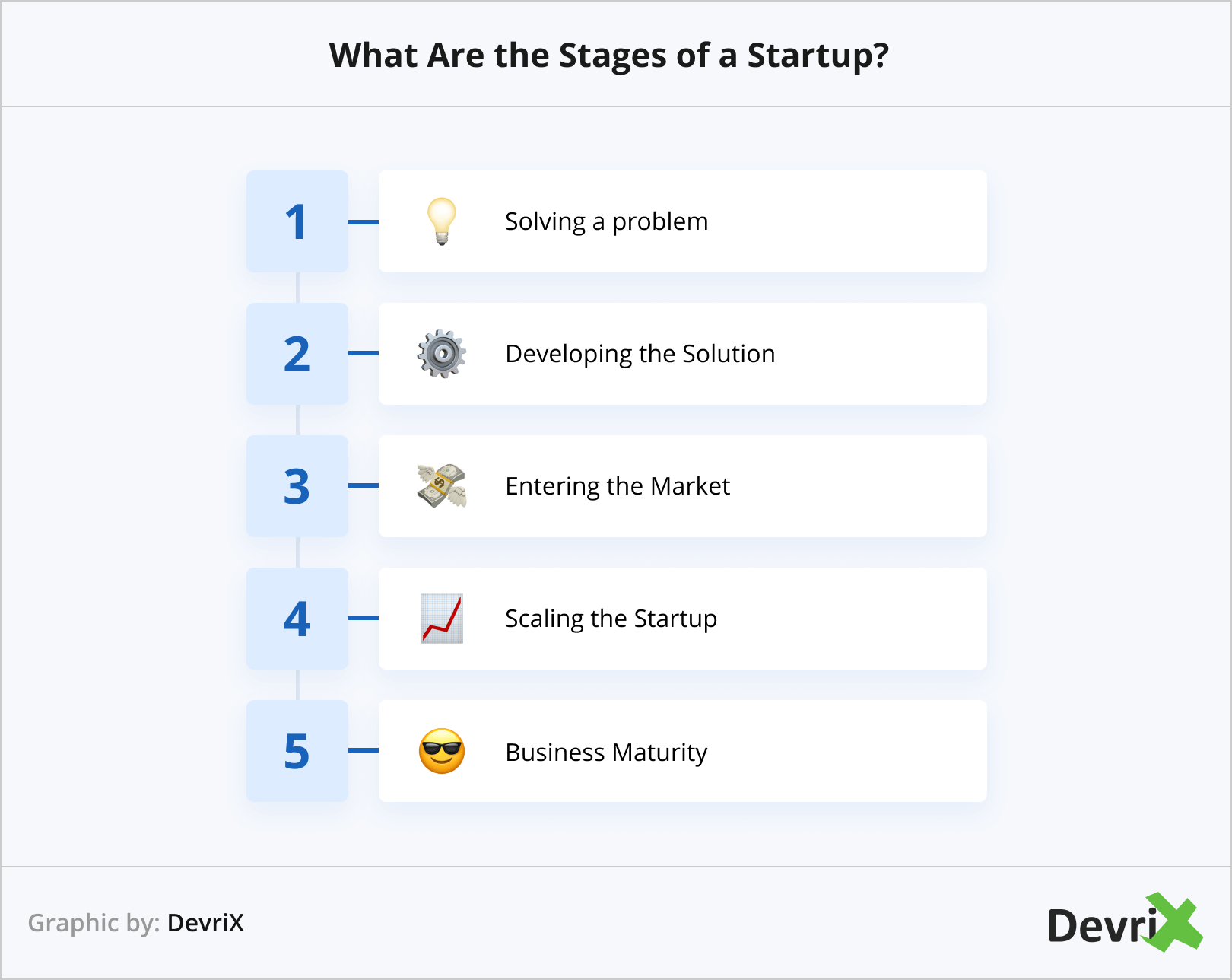Starting a startup, and developing it, is no piece of cake. You need to have a great idea, write your startup business plan, and much more.
Overall, the journey of a startup is long, hard, and full of both expected and unexpected difficulties. That is why the various phases are broken down into stages – each with its own objectives, considerations, and necessities.
Today, we are going to review the stages of a startup, so we can better understand the what, where, when, and why.
Keep in mind that there are various definitions and outlines of the startup life cycle stages out there, however we prefer to define and explain the process in a simpler, and understandable fashion.
Let’s get started.
Readers Also Enjoy: How to Start a SaaS Startup in 2023 – DevriX
What Are the Stages of a Startup?

- Solving a Problem
- Developing the Solution
- Entering the Market
- Scaling the Startup
- Business Maturity
1. Solving a Problem
The very first step towards starting a startup is to come up with a solution for a major problem that consumers face, which has remained without an answer, so far. Alternatively, there could be a solution out there, but you have a different idea in mind. Or, you may want to improve the existing solution with innovation, a better service/product, and so on.
This step is typically referred to as an early stage startup. It is the moment when you need to think of a great idea, and let it evolve until it can become a product or service ready for the market.
At this point, startups usually already have a team, albeit a small one, and sometimes even one-two people. This is also the time to think about funding, which is one of the most important aspects of business. In fact, more than one third of startups failed, because they ran out of money, or failed to acquire new capital.
The initial process of gathering finances is also known as seed funding, which fall into Series A, B, and C.
Here is a bit more about the startup funding process:
- Pre-seed funding. This is the earliest stage of funding a newly created company. It comes so early that it is frequently not even included in the major funding rounds. In the simplest terms, this is the initial funding by the owner that gets the project up and running. The investment usually comes from personal savings, friends and family, etc.
- Seed funding. This phase represents the first funds that your business raises. The goal of this is to help your business grow. For example, companies invest in market research, and product development. However, just like in reality where a real garden is concerned, the seed funding is uncertain at this point, and unfortunately, many companies never get past this round and grow into something substantial (trees).
- Series A funding. What is essential for this phase of funding is to have a business plan for long-term development and profit. A lot of times, companies manage to gather enthusiastic investors, but without a well thought out idea of how to monetize their business, it is sure to fail. Generally, the series A funding accumulates $2-15 million, with the average in 2021 being $10 million.
- Series B funding. Only well-established companies with valuations between $30-60 million reach this stage of funding. The main difference, when compared to Series A funding, is the addition of (new) venture capital firms that specialize in later-stage investment.
- Series C funding. Companies that get to this stage are already quite successful. Still, they may need more funding for things like developing new products, reaching new markets, and even acquiring smaller companies. Series C is all about fast scaling, growth and success.
Readers Also Enjoy: What Is the Best Organic Growth Strategy for Startups? – DevriX
2. Developing the Solution
The second major stage in the life cycle of a startup is the development of your solution. In other words, what are you going to do with the great idea you have, is there enough interest in it, how will you monetize it, etc.
More often than not, in order to understand whether you are fully prepared or not, you need to write a proof of concept (PoC), or create a minimal viable product (MVP).
Although different, both serve the purpose of an early test of your product/service/idea. You can gather early feedback, theoretically validate your concept, identify potential business/technical/logistical issues, and determine how to develop your product or service, when the time comes to move it to production.
Additionally, while you do not need to have a fully-functional product/service at this time, you need to be able to prove that it is worth investing.
Readers Also Enjoy: How to Grow a Small Business in 2023? – DevriX
3. Entering the Market
After you are done with the MVP or prototype development, it is time to think about entering the market. Naturally, before doing so, it is essential to conduct proper market research, analyze the competitive landscape, establish your target audience, and more.
You should use the early stages to experiment, and collect feedback from early customers – what they would improve in the product/service you are offering, would they use it again, is the pricing you have set adequate, how happy are they with the product/service, and so forth.
Basically, any questions that can provide you with insights on how to make your product or service better. Keep in mind that this step is much harder than it sounds, and is often the cause of startup headaches.
Another important aspect you need to consider is your pitch for seed funding or Series A funding – in practice, this would be how would you spark the interest of your potential investors and convince them that you are well worth investing in.
Readers Also Enjoy: Product Marketing: The MVP of Launching a New Product – DevriX
4. Scaling the Startup
After solving a few hundred problems successfully, you are now at the scaling stage. Congratulations, not everyone makes it here! Most get lost in the different stages of a startup, and simply cease to exist.
The fact that you have reached this point means that you have chosen well and executed a marketing strategy with success, your business is self-sustainable, and your product or service is profitable.
However, now is not the time to sit back, rest, and admire your success. This is the perfect moment to scale, and the main keyword here is profitability.
Scaling requires careful planning, and you must be able to identify potential bottlenecks or limitations in your current operations and invent strategies to overcome them.
At this stage, you need to consider technology infrastructure, production capacity, team structure, distribution channels, and so forth.
Another good idea is to focus on customer acquisition and retention, since acquiring new customers while retaining existing ones is crucial if you want to scale successfully.
Make sure to analyze your target market, refine your marketing strategies, and allocate resources so that you can reach a broader audience. It’s also a good idea to implement customer acquisition tactics such as digital marketing, partnerships, referral programs, and targeted advertising.
Additionally, make sure to prioritize customer satisfaction and loyalty through exceptional service and support, as that will most likely bring in more customers, and more revenue in the long run.
Furthermore, this is the time to assemble a team of top talent for your startup, since scaling cannot generally be done without a capable and dedicated team.
Take the time to evaluate the strengths and weaknesses of your current team. Also, hire new people to fill in any skill gaps. Look for individuals who are passionate about your vision, are adaptable, and can work in a dynamic startup environment. In addition, you should foster a positive company culture that promotes collaboration, innovation, and continuous learning.
Readers Also Enjoy: How to Calculate Customer Acquisition Cost and 10 Ways to Reduce It – DevriX
5. Business Maturity
You now own a profitable business! It was not easy to get here, as, in fact, only 40% of startups are profitable, and 50% of all startups fail within the first five years.
Reaching the mature stage, a.k.a. the exit stage, means that your startup has achieved stability and sustainable growth. It has a clear and concise market position, a strong customer base, and consistent revenue streams.
The focus is on optimizing existing operations, obtaining more profitability, and potentially exploring options for an exit strategy, such as an acquisition or an initial public offering (IPO).
Readers Also Enjoy: Supreme Startup Guide: Success From Start to Finish – DevriX
Summary
All stages of a startup require an equal amount of attention, hard work and dedication. You should not try to hurry through any of these stages. Instead, take as much time as you need to make sure you are ready for the next step.
Invest your time and resources carefully, and never disregard crucial aspects such as human resources, budget allocation, marketing strategies, market research, defining your target audience, and so on.
We would like to remind you that at DevriX, we offer business and marketing consulting services and are always here if you need a helping hand.




